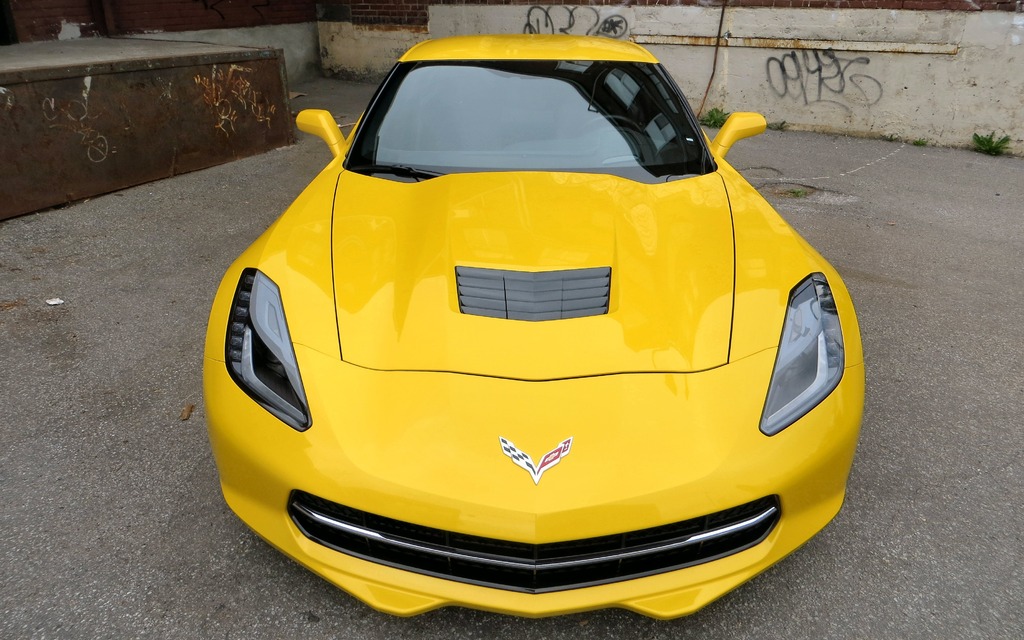2014 Chevrolet Corvette Stingray: Maximum Volume


I couldn't tell which sound was louder when I revved the engine of the 2014 Chevrolet Corvette Stingray: the cacophony of its two-stage exhaust system venting eight cylinders of spent fuel to the sky, or the wails of all of those second-hand sports car shoppers realizing that they aren't going to get a bargain on this coupe once it hits used dealer lots in three years time. You see for the last 15 years the Corvette has been the over-achieving high performance ride that you could snag for half-price if you were patient, as depreciation combined with a Fisher-Price interior and concerns about build quality to slash the window sticker. But not anymore.
Nope. Those days are over, as the 2014 Chevrolet Corvette Stingray has finally been given the staying power it needs to shine on the world stage for more than just the 12 months it'll take for that 'new car' smell to dissipate from the interior. The Stingray presents a complete package that will see residual values floating higher than ever before in Corvette history - and keep more of them safely ensconced in garages rather than plying Craigslist.
Read also
Top Banana
So what if you don't really care about the long-term value proposition of the 2014 Chevrolet Corvette Stingray but are more concerned about what makes the car such a strong buy in the first place? Where to begin. How about with the Stingray's exterior styling, which is perhaps the only real sticking point amongst fans of the Bowtie-wearing coupe. Festooned with hard angles and air vents (all of which are functional, of course), and featuring the first set of non-round tail lights on a Vette, the car has managed to offend a very vocal group of purists in the Corvette community. Everyone else, however, seems to like it just fine, even in the eye-searing yellow of my test vehicle which attracted numerous compliments during our time together.
While the shape of the Corvette Stingray's composite body might be a matter of taste, the car's interior trappings certainly are not. No matter how you look at it, Chevrolet has seriously stepped up its game in furnishing the Corvette's cabin with high end plastics and leather, appealing trim, and a fully modern set of screens, gauges, and controls. The top-tier 3LT edition of the car that I drove had all of the bells and whistles, including the MyLink vehicle interface, a reconfigurable instrument cluster with many different performance-related data displays, and a full-colour head-up display that projected out over the hood.
Passenger room is better than you might expect inside the coupe, and the Corvette continues to school its more exotic rivals when it comes to cargo space: in fact the vehicle's lightweight painted carbon fibre roof panel can be stowed in the trunk once removed, with plenty of space underneath for sliding in smaller bags or items. The car's seats also gripped my body tight thanks to their aggressive bolstering, answering complaints made by generations of Vette owners sick of their posteriors sliding sideways through corners. However, I found that at the end of the day they had beat my back into submission, leaving me surprisingly sore after longer trips.
The Quickest Factory Vette Yet
While you definitely could take an extended road trip in the 2014 Chevrolet Corvette Stingray (provided you brought a back pillow), or putter around town running errands, you'd be missing the point of the car if you didn't occasionally take it to a stretch of road where you could fully exercise its exceptionally well-tuned chassis and hotted-up eight-cylinder engine. The 6.2-liter V8 mill found under the hood of the car produces 455 horsepower and 460 lb-ft of torque, or in the case of the model I drove, 460 horsepower and 465 lb-ft of twist thanks to the performance exhaust that was installed. It also comes with variable valve timing and cylinder deactivation technology to help save fuel at cruising speeds, but honestly who cares: the Stingray deserves to live at the redline, and rewards drivers who are willing to play ball.
My tester was even more effective at the limit thanks to the installation of the Z51 package, a relatively affordable $5,000 add-on to the base Corvette that tightens up the gear ratios in the car's seven-speed manual transmission (a six-speed autobox is also available), provides stiffer shocks, installs bigger brakes and an electronically-controlled limited-slip differential, and even piles on a dry-sump oiling system for the engine (you also get bigger wheels and tires, 19-inches in the front and 20-inches at the rear). Further enhancing the stability and control of the Stingray I drove was a magnetically-controlled suspension system that was paired with a five-stage performance traction management feature that included launch control.
Outrageous Enough
The 2014 Chevrolet Corvette Stingray assembles all of the above attributes into a fearsome track-day weapon and formidable back-road-eater. The car is incredibly quick in almost any driving situation, launching to 100 km/h in just under four seconds while its magnetic ride control system sticks the car to the roads like they were made of cast iron. It's almost too much of a bravura performance: unless you're lighting up the tires, the Corvette Stingray feels more competent than dramatic, swapping some of the older Vette's brawny charm for Olympic-calibre execution. Is this a bad thing? Certainly not - after all, everyone's personality changes as they age, and when you consider how many decades we've been gifted with having a Corvette on the market, a little maturity is more than welcome at this stage in the game.








